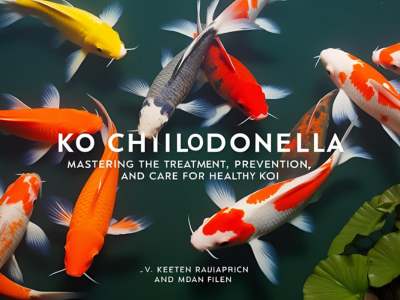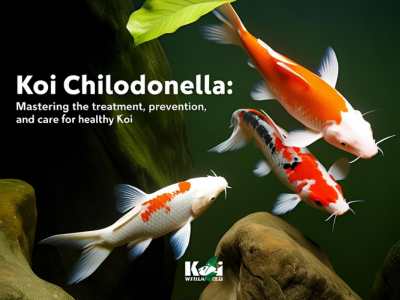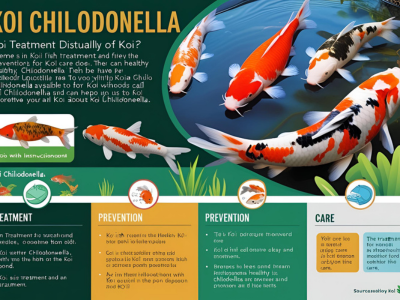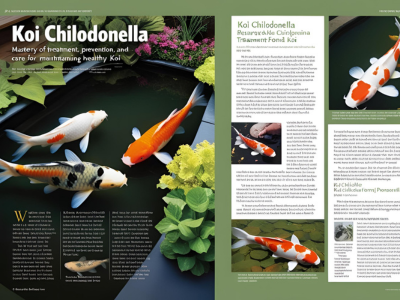Introduction
If you have a koi pond, you already know how wonderful and peaceful these fish are. But sometimes koi can get sick, and one common problem is Koi Chilodonella.
Chilodonella is a tiny parasite that can make koi fish and goldfish very sick if not treated quickly. In this easy guide, we’ll learn what Chilodonella is, how to spot it early, how to treat it, and how to stop it from coming back. Let’s dive into the world of koi health and learn how to protect your beautiful fish!
What is Chilodonella in Koi Fish?
Chilodonella is a microscopic parasite that attacks koi fish and goldfish. You can’t see it with your eyes because it’s super tiny, but it can do a lot of damage.

This parasite sticks to the skin, gills, and fins of the fish. It makes it hard for them to breathe and can cause sores or extra slime on their bodies.
When koi have Chilodonella, they may:
- Scratch against rocks or plants
- Swim slowly or look tired
- Gasp for air at the surface
- Show red spots or cloudy skin
If you see these signs, it’s important to act quickly!
Common Questions:
- What is Chilodonella fish disease?
It’s a disease caused by the Chilodonella parasite that affects the skin and gills of koi fish and goldfish. - What does Chilodonella look like?
You can’t see it without a microscope, but the fish will show symptoms like scratching and heavy breathing.
Symptoms of Koi Chilodonella Infection
If your koi have Chilodonella, you might notice:
- Extra slime: A thick layer of mucus on the fish’s body
- Gasping for air: Fish swim at the surface struggling to breathe
- Scratching: Fish rub against pond sides or decorations
- Redness or sores: Visible red patches, wounds, or damaged fins
- Cloudy skin: Skin might look dull or pale
These are all signs that your koi could have Chilodonella and need help.
What Causes Chilodonella in Koi?
Chilodonella infections usually happen when the pond environment is unhealthy. Here are the main causes:
- Poor water quality: Dirty or unbalanced water can make koi weak.
- Stress: Moving koi to a new pond or sudden changes in water can stress them out.
- Overcrowding: Too many fish in a small pond cause stress and spread disease faster.
- Temperature changes: Very cold or hot water weakens fish and helps parasites grow.
To keep koi happy and strong, you must have clean water and a healthy pond!
Koi Chilodonella Treatment
If you think your koi have Chilodonella, don’t wait! Here’s how you can treat it:
1. Formalin and Malachite Green
These are medicines you can add to the pond. They kill the parasites safely if used properly.
2. Salt Baths
Give your koi a special saltwater bath. This can kill some parasites and help your fish heal faster.
How to do it:
- Mix pond salt with water (ask your pet store for safe amounts).
- Place your koi in the salt bath for 5–10 minutes.
- Watch them closely!
3. Raise the Water Temperature
By gently raising the water temperature (no more than 2°F per day), you can speed up the parasite’s life cycle, making treatment more effective.

Important: Always follow directions when using treatments. Too much medicine or heat can harm your fish!
Prevention of Chilodonella in Koi
Preventing Chilodonella is easier than treating it! Here’s what you should do:
- Test your pond water weekly: Check for ammonia, nitrate, pH, and oxygen levels.
- Quarantine new fish: Before adding new koi, keep them in a separate tank for 2–4 weeks to make sure they are healthy.
- Clean your pond regularly: Remove old leaves, waste, and uneaten food.
- Use a good filter: A strong filter keeps the water clean and safe.
- Feed koi a healthy diet: Good food keeps their immune system strong.
By following these simple steps, you can prevent most koi parasite problems, including Chilodonella.
What is Koi Epistylis?
Koi Epistylis is another parasite that can affect koi fish. While it is different from Chilodonella, it can still cause trouble.
Signs of Epistylis infection include:
- Cloudy areas around the eyes
- Swelling
- Fish acting slow or tired
It’s important to know if your koi has Epistylis or Chilodonella because treatments might be a little different.
Chilodonella in Goldfish vs Koi
Chilodonella can infect both koi and goldfish. But there are small differences:
- In koi, you often see redness and slime on the body.
- In goldfish, you might see more breathing problems first.
The good news is the treatment is mostly the same for both fish. Just be sure to check the symptoms carefully.
Chilodonella in Humans: Myth or Reality
Many people ask:
Can Chilodonella infect humans?

The answer is NO.
Chilodonella only affects fish. It cannot make people sick. However, it’s a smart idea to always wash your hands after handling fish or pond water to stay clean and safe.
Costia Koi: How is It Different from Chilodonella?
Costia is another tiny parasite that causes sickness in koi fish. It is even more dangerous than Chilodonella.
Costia symptoms:
- Fish breathing very heavily
- Lying on the pond bottom
- Severe redness and sores
Treating Costia is similar to treating Chilodonella, but you might need stronger medicine if the infection is bad.
Other Common Koi Parasites

Besides Chilodonella and Costia, koi fish can get other parasites too. Some common koi parasites include:
- Ich (White Spot Disease): White dots on the skin and fins
- Trichodina: Causes flashing and slimy skin
- Velvet: A golden dust on the fish’s body
Each parasite has different symptoms, so knowing how to spot them early is important. Keeping your pond clean and testing your water often will help keep parasites away!
Best Review
Taking care of koi fish is a big but wonderful responsibility. Chilodonella is one of the common problems koi owners face, but with the right care, you can keep your fish safe and healthy.
Remember:
- Watch for symptoms early.
- Treat quickly if you see signs.
- Keep your pond clean and your koi stress-free.
- Quarantine new fish before adding them to your pond.
With good care and attention, your koi can live long, happy, and colorful lives in your pond!
FAQs
What is Chilodonella in Koi Fish?
Chilodonella is a tiny parasite that sticks to koi fish and makes them sick by causing mucus buildup and breathing problems.
How Do I Treat Chilodonella in My Pond?
Use medicines like formalin or malachite green, give salt baths, and raise the water temperature carefully.
Can Chilodonella Affect Goldfish?
Yes! Goldfish can also get Chilodonella, but they may show more breathing problems first.
Is Chilodonella Dangerous to Humans?
No. Chilodonella only affects fish. Humans are safe but should wash hands after touching pond water.




